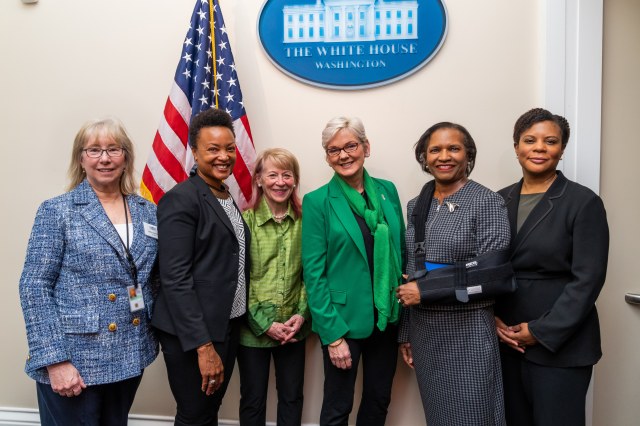The Next Energy Revolution Begins Now
By Dr. Sally Benson, OSTP Deputy Director for Energy
Unless you hang out with energy wonks, you might not have noticed the exponential adoption of clean energy technologies right now. After being available for years, plug-in electric vehicle sales are taking off – their percentage of sales of doubled between 2020 to 2021, and is poised to double again in 2022. Consumers can now buy electric vehicles that can go hundreds of miles on a single charge and never visit a gas station again.
The cost of solar power has dropped 90 percent in the past decade – making it one of the cheapest sources of electricity. Offshore wind power technology has improved so much that last month saw the highest-grossing offshore lease bidding the Federal government has ever had for any energy source – including oil and gas leases. But it wasn’t always that way. In the 1970’s electricity produced from solar cost 100 times more than grid power. Wind turbines were unreliable and produced a small fraction of the power today’s turbines can. And electric vehicles could only drive about 40 miles before the battery ran out.
When facing a devastating energy crisis in the 1970’s that had families waiting in line for hours at gas stations and disrupted our economy, America made sweeping and bold investments in electric vehicles, solar power, wind turbines, and batteries. Those investments improved performance and drove down costs. Now, while we shift into higher gear and deploy these technologies at full speed, it’s time to give the next generation of clean-energy technologies a running start.
What if instead of just capturing the Sun’s energy when it’s shining, we could also replicate it? While sunlight powers our solar panels, the Sun itself derives its power from multiple atoms fusing together and releasing energy – a process called fusion. If the conditions that cause atoms to fuse in the sun could be created in a power plant here on Earth, it’s like capturing a star in a bottle, giving us a near-limitless safe and constant source of the clean electricity. A fusion power plant uses earth-abundant fuels, such as deuterium from seawater and lithium. The amount of fusion fuel that could fill a bathtub holds as much energy as all the petroleum Russia produces each day – about 10 million barrels.
If you’ve heard of fusion, I know what you may be thinking: fusion is the stuff of science fiction, it’s 30 years away, and as the energy crowd jokes, “it always will be.” But just like the solar and wind revolution right now, a revolution in fusion science is beginning.
We never know when advances in one technology will spillover to help other technologies. Industrial improvements in controllable motors helped wind turbines become competitive and improvements in semiconductors and power inverters helped solar power. Over the past decade, there have been big advances in superconducting magnets, power electronics, and computer simulation capabilities that are beginning to spillover to help fusion power. These advances, combined with decades of public research in fusion science from the Department of Energy, other U.S. agencies, and governments around the world, are to starting to put fusion power within the realm of possibility. Just this last year, major scientific breakthroughs in fusion science and technology have been reported from the U.S., UK, and China. Private sector start-ups and the investment community have taken notice. Now there are at least 19 U.S.-based private fusion startups, which have raised billions of dollars from investors who see the potential of fusion.
My team at the White House Office of Science and Technology Policy (OSTP) is responsible for working with agencies across the government to accelerate game-changing clean energy technologies to help achieve President Biden’s goal of a net-zero emissions economy by 2050. Recently, OSTP and the Department of Energy co-hosted the first White House Fusion Summit to inform development of a bold decadal strategy to accelerate the viability of commercial fusion energy. The hybrid virtual and in-person summit drew more than 1,200 viewers on the livestream and brought together fusion energy leaders from government, industry, academia, and other stakeholders including environmental justice experts to showcase progress, and have inclusive conversations about the future of fusion science and technology.
The Biden-Harris Administration is focused on building a clean energy future that creates good-paying jobs, lowers energy bills, and supports a path toward U.S. energy independence by manufacturing and deploying clean energy for the benefit of all Americans. Five decades ago, the U.S. government built the science and technology foundation that enables today’s clean energy revolution. Even as we aggressively deploy those technologies, we need to keep innovating to unlock the next generation of clean energy technologies: in fusion, energy storage, clean manufacturing, and more. Decades from now, let’s look back on this moment as a time when we again acted boldly to make the impossible possible.

The White House Fusion Summit featured remarks from key leaders, who spoke about the President’s commitment to clean energy science and technology and the need for innovation to benefit all communities. [Pictured left to right: Sally Benson, Deputy Director for Energy, White House Office of Science and Technology Policy; Shalanda Baker, Secretarial Advisor on Equity and Deputy Director for Energy Justice, Department of Energy; Geraldine Richmond, Under Secretary for Science and Innovation, Department of Energy; Jennifer Granholm, U.S. Secretary of Energy; Brenda Mallory, Chair, Council on Environmental Quality; Alondra Nelson, Head of the Office of Science and Technology Policy and Deputy Assistant to the President. The event also featured remarks by National Climate Advisor Gina McCarthy, not pictured] (Official White House Photo by Cameron Smith)
###

